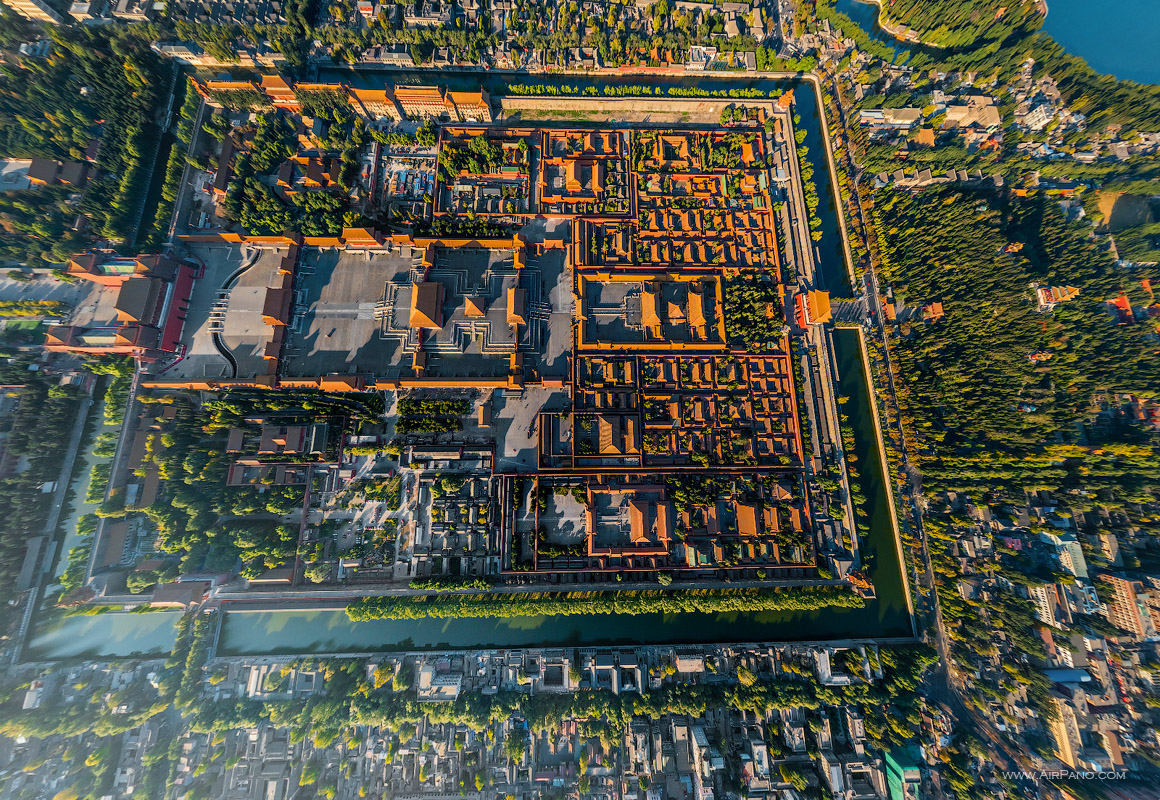

Įven before the palace was completed, Zhu Di moved to Beijing under the guise of "touring and hunting" (巡狩): the administrative centre of the empire gradually shifted from Nanjing to Beijing.

Soil excavated during construction of the moat was piled up to the north of the palace to create an artificial hill, the Jingshan hill. Much of the interior pavings seen today are six-century-old originals. Each batch took months to bake, resulting in smooth bricks that ring with a metallic sound. The floors of major halls were paved with "golden bricks" ( Chinese: 金砖 pinyin: jīnzhuān), baked with clay from seven counties of Suzhou and Songjiang prefectures. Instead, wells were dug along the way, and water from the wells was poured on the road in deep winter, forming a layer of ice. The larger pieces could not be transported conventionally.

The grand terraces and large stone carvings were made of stone from quarries near Beijing. Such a feat was not to be repeated in subsequent years – the great pillars seen today were rebuilt using multiple pieces of pinewood in the Qing dynasty. The pillars of the most important halls were made of whole logs of precious Phoebe zhennan wood ( Chinese: 楠木 pinyin: nánmù) found in the jungles of south-western China. Ĭonstruction lasted 14 years and employed the work of 100,000 skilled artisans and up to a million labourers. The chief architects and engineers include Cai Xin, Nguyen An, a Vietnamese eunuch (unverified information), Kuai Xiang, Lu Xiang and others. The Forbidden City's plan was designed by many architects and designers, and then it was examined by the emperor's Ministry of Work. He made Beijing a secondary capital of the Ming empire, and construction began in 1406 of what would become the Forbidden City. In 1402, Zhu Di usurped the throne and became the Yongle Emperor. His son Zhu Di was created Prince of Yan with his seat in Beijing. After the collapse of the Yuan dynasty, the Hongwu Emperor of the Ming dynasty moved the capital of China from Beijing in the north to Nanjing in the south, and in 1369 ordered that the Yuan palaces be razed. The site of the Forbidden City was situated on the Imperial city during the Mongol Yuan dynasty. Construction and Ming dynasty The Forbidden City as depicted in a Ming dynasty painting In 1987, it was declared a World Heritage Site by UNESCO. After serving as the imperial palace for some five hundred years, the Forbidden City became a museum, the Palace Museum, in 1925. It is located in the centre of Beijing, China, and was the Chinese imperial palace from the early- Ming dynasty in 1420 to the end of the Qing dynasty in 1912, continuing to be home of the last emperor, Puyi, until 1924, since then it has been a museum.īuilt from 1406 to 1420, the palace complex has undergone many changes. The Forbidden City was first built in the early-15th century as the palace of the Ming emperors of China. At the end of the tour you can enjoy the view from Belvedere on the Pfingstberg.View of the Forbidden City from Jingshan Park Other highlights include the Russian colony Alexandrowka, the New Garden, the Marble Palace, and Cecilienhof Palace. Then, drive through the Dutch Quarter to reach the Bornstedt Crown Estate, from where you’ll walk towards Sanssouci Park. Nicholas' Church, the Old Town Hall, and the new state parliament. See burial vaults, family graves, and private cemetery sections of famous personalities.Ĭross over the Glienicke Bridge and the Berlin suburbs to the Old Market Square with St. 7,” also known as the “forbidden city.” See the last vestiges of the Soviet occupation and discover interesting facts about the history of this place.Įxplore the remand prison of the Soviet Military Counterintelligence at Leistikowstraße 1, the epitome of torture and torment for thousands of Germans and Soviet military personnel, now a memorial and meeting place.Įxplore the somewhat remote Bornstedt Cemetery, a place filled with mystery, secrets, and history. DescriptionDiscover the UNESCO World Heritage Site of Potsdam on this exciting tour from Berlin.


 0 kommentar(er)
0 kommentar(er)
